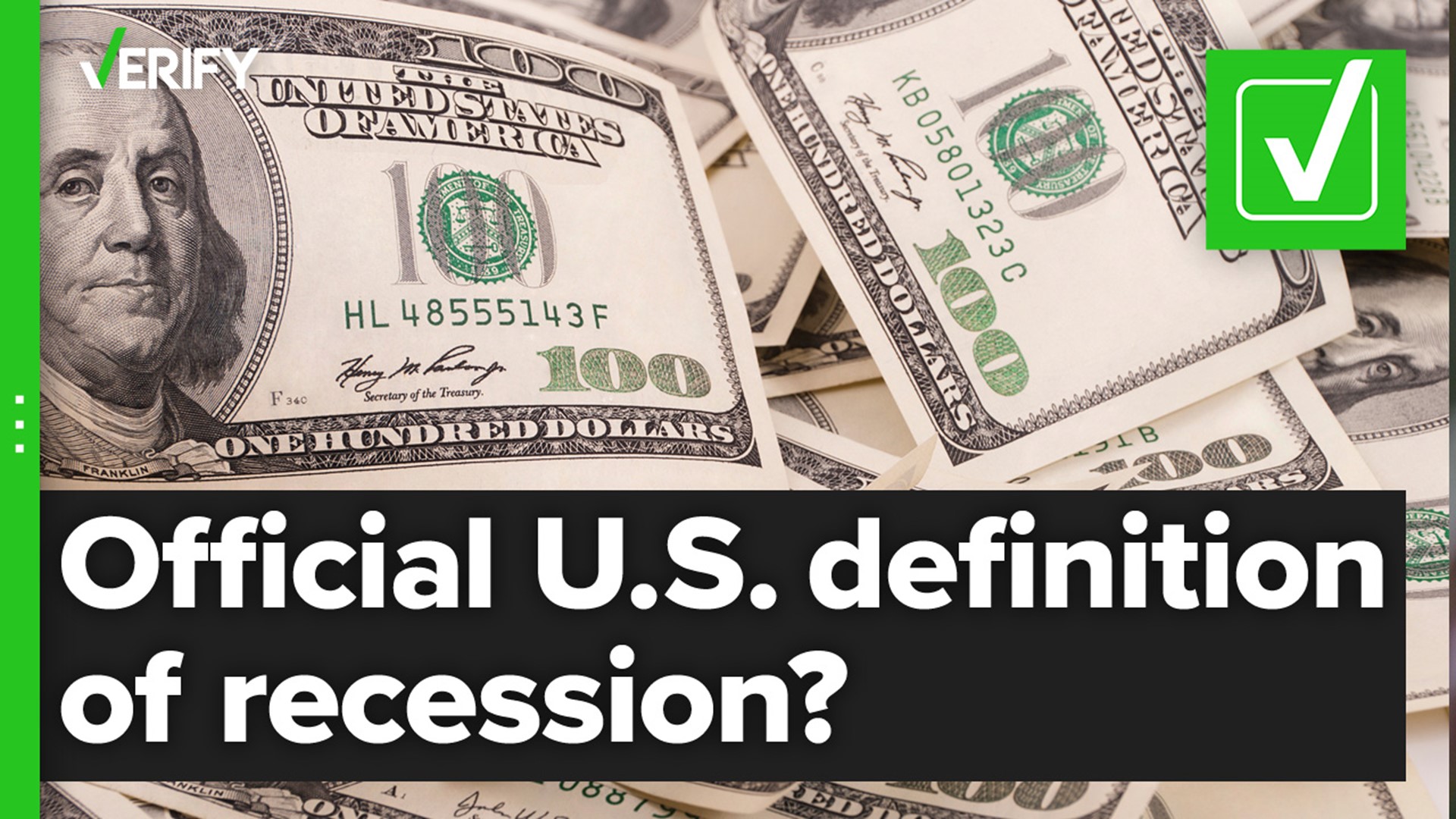The U.S. Commerce Department reported on July 28 that the nation’s gross domestic product (GDP) fell at an annual rate of 0.9% in the second quarter, marking two consecutive quarters of decline.
GDP generally measures the monetary value of goods and services produced in a country during a given time period, such as a quarter or year.
The recent declines have sparked fears that a recession is on the horizon, since many on social media claim a recession is defined by two consecutive quarters of negative GDP growth. But the White House says this isn’t accurate, writing “that is neither the official definition nor the way economists evaluate the state of the business cycle.”
Multiple VERIFY readers have reached out to ask what constitutes a recession and if there is an official definition.
THE QUESTION
Is there an official definition of a recession?
THE SOURCES
- National Bureau of Economic Research (NBER)
- U.S. Bureau of Economic Analysis (BEA)
- International Monetary Fund
- Corporate Finance Institute
- Alan Gin, Ph.D., associate professor of economics at the University of San Diego’s Knauss School of Business
THE ANSWER
Yes, there is an official definition of a recession – and it’s not two quarters in a row of declining GDP.
WHAT WE FOUND
A committee within the National Bureau of Economic Research (NBER), a nonprofit research organization that’s not affiliated with the federal government, determines when the U.S. economy has entered into a recession.
A recession is defined by the NBER as a “significant decline in economic activity spread across the economy, lasting more than a few months.” The organization takes into account many factors, including GDP, real income, employment, industrial production, and consumer spending, in its determination.
Though people often cite two consecutive quarters of GDP decline as the definition of a recession, and countries like Great Britain use this designation, it is not an “official designation” in the U.S., according to the Bureau of Economic Analysis, an independent, federal statistical agency.
The NBER definition is a “better approach” to defining a recession than GDP declines alone, Alan Gin, an economics professor at the University of San Diego, told VERIFY.
“There's some quirks in terms of the GDP that kind of makes it not necessarily a good measure as far as how the economy is going,” he said. “For example, there are two big areas that could be distorting. One is in the area of international trade and the other is in the term of business inventories.”
When it comes to international trade, the number of items imported into the U.S. is a metric that could have both positive and negative implications for the American economy. For example, imports can lead to GDP declines because the U.S. is sending more of its money overseas. However, if the U.S. is importing many goods from other countries, that can actually signal that the economy is growing and people have incomes to buy the imported products, Gin explained.
“During the first quarter of the year, the economy was down, as measured by GDP, -1.6%. But a big part of that was due to a big surge in imports,” he said. “And again, that's more of a sign of strength of the U.S. economy as opposed to a weakness.”
Businesses drawing down from their inventory, or selling existing inventory while not buying more, is also considered negative for GDP, which contributed to declines in the second quarter, according to Gin. But it’s unclear right now whether that’s a positive or negative signal for the strength of the U.S. economy.
So has the U.S. met the definition of a recession? NBER hasn’t declared one and it often takes them a long time to do so. Sometimes, a recession is over by the time the organization declares there was one, according to Gin.
Gin says he doesn’t think the U.S. is in a recession right now, though it could happen in the future. But, right now, consumer spending is on the rise, and industrial production and job growth remain strong, which are positive signs for the economy, he said.
According to the Corporate Finance Institute, during a recession, “the demand for goods and services starts declining rapidly and steadily.” Since producers don’t notice this drop in demand right away, there is excess supply in the market. All positive economic indicators such as income, output and wages also start to fall as a result.
At the beginning of the COVID-19 pandemic in 2020, the U.S. entered into a brief recession, according to the NBER.
“I think the pandemic was just a once-in-a-lifetime thing that caused disruptions in the economy,” Gin said. “But in the last four years, one area that was disrupted was the labor market. Huge numbers of people retired early, some people died or got long COVID as a result of the disease, and therefore are out of the labor market.”
As for whether the U.S. is currently headed toward meeting the definition of another recession, only time – and not claims on social media – will tell.

